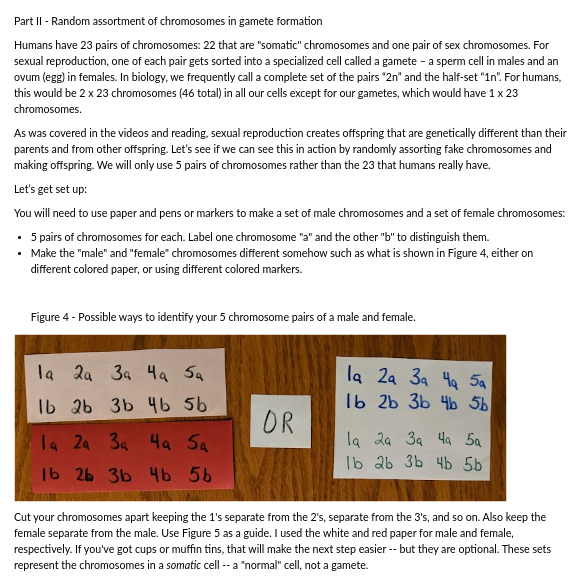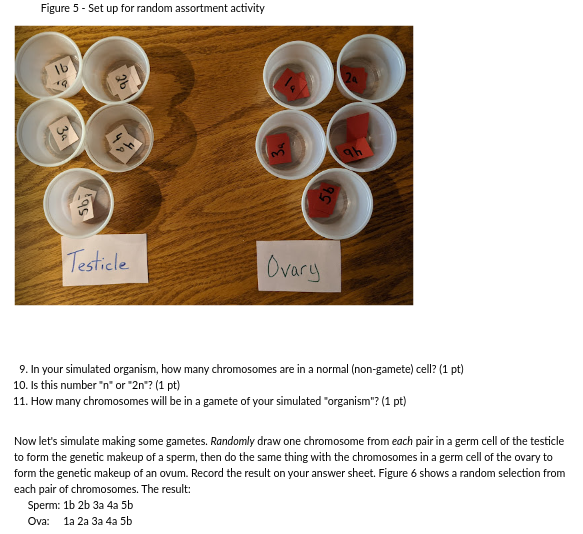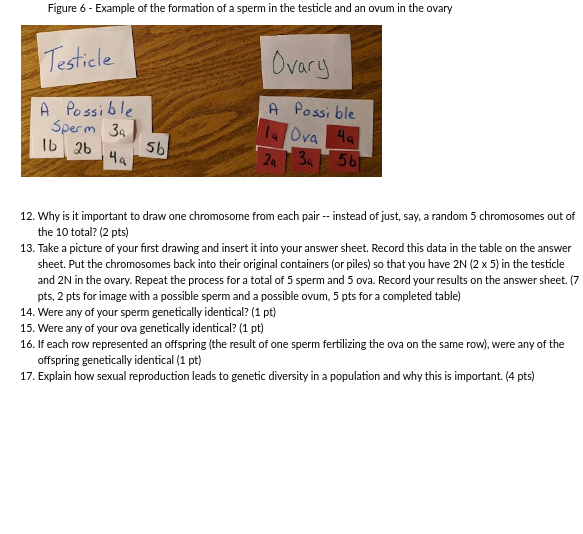Home /
Expert Answers /
Biology /
part-ii-random-assortment-of-chromosomes-in-gamete-formation-humans-have-23-pairs-of-chromosomes-pa665
(Solved): Part II - Random assortment of chromosomes in gamete formation Humans have 23 pairs of chromosomes: ...



Part II - Random assortment of chromosomes in gamete formation Humans have 23 pairs of chromosomes: 22 that are "somatic" chromosomes and one pair of sex chromosomes. For sexual reproduction, one of each pair gets sorted into a specialized cell called a gamete - a sperm cell in males and an ovum (egg) in females. In biology, we frequently call a complete set of the pairs " " and the half-set " ". For humans, this would be chromosomes ( 46 total) in all our cells except for our gametes, which would have chromosomes. As was covered in the videos and reading, sexual reproduction creates offspring that are genetically different than their parents and from other offspring. Let's see if we can see this in action by randomly assorting fake chromosomes and making offspring. We will only use 5 pairs of chromosomes rather than the 23 that humans really have. Let's get set up: You will need to use paper and pens or markers to make a set of male chromosomes and a set of female chromosomes: - 5 pairs of chromosomes for each. Label one chromosome "a" and the other " " to distinguish them. - Make the "male" and "female" chromosomes different somehow such as what is shown in Figure 4, either on different colored paper, or using different colored markers. Figure 4 - Possible ways to identify your 5 chromosome pairs of a male and female. Cut your chromosomes apart keeping the 1's separate from the 2's, separate from the 3's, and so on. Also keep the female separate from the male. Use Figure 5 as a guide. I used the white and red paper for male and female, respectively. If you've got cups or muffin tins, that will make the next step easier -- but they are optional. These sets represent the chromosomes in a somatic cell -- a "normal" cell, not a gamete.
Figure 5 - Set up for random assortment activity 9. In your simulated organism, how many chromosomes are in a normal (non-gamete) cell? (1 pt) 10. Is this number " " or " "? (1 pt) 11. How many chromosomes will be in a gamete of your simulated "organism"? (1 pt) Now let's simulate making some gametes. Randomly draw one chromosome from each pair in a germ cell of the testicle to form the genetic makeup of a sperm, then do the same thing with the chromosomes in a germ cell of the ovary to form the genetic makeup of an ovum. Record the result on your answer sheet. Figure 6 shows a random selection from each pair of chromosomes. The result: Sperm: Ova: 1a 2a 3a 4a 5b
Figure 6 - Example of the formation of a sperm in the testicle and an ovum in the ovary 12. Why is it important to draw one chromosome from each pair - instead of just, say, a random 5 chromosomes out of the 10 total? (2 pts) 13. Take a picture of your first drawing and insert it into your answer sheet. Record this data in the table on the answer sheet. Put the chromosomes back into their original containers (or piles) so that you have in the testicle and in the ovary. Repeat the process for a total of 5 sperm and 5 ova. Record your results on the answer sheet. ( 7 pts, 2 pts for image with a possible sperm and a possible ovum, 5 pts for a completed table) 14. Were any of your sperm genetically identical? (1 pt) 15. Were any of your ova genetically identical? (1 pt) 16. If each row represented an offspring (the result of one sperm fertilizing the ova on the same row), were any of the offspring genetically identical (1 pt) 17. Explain how sexual reproduction leads to genetic diversity in a population and why this is important. (4 pts)